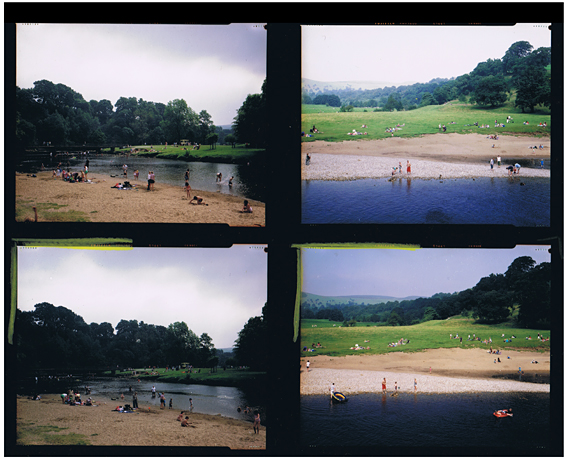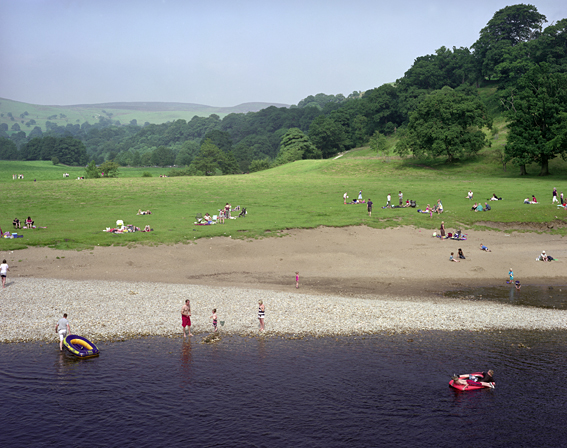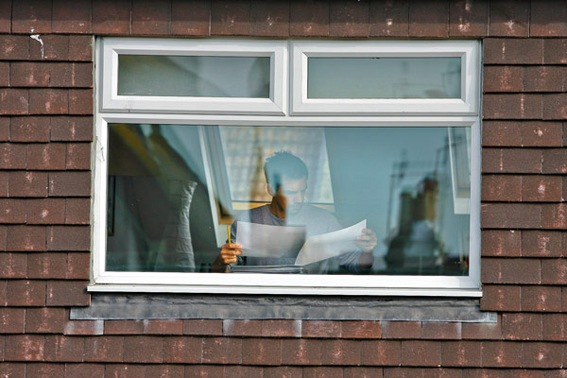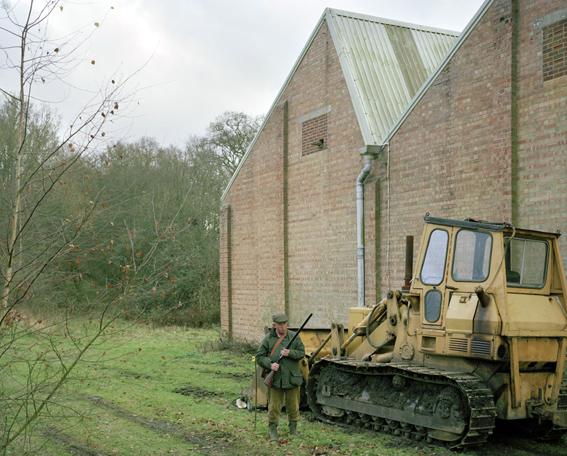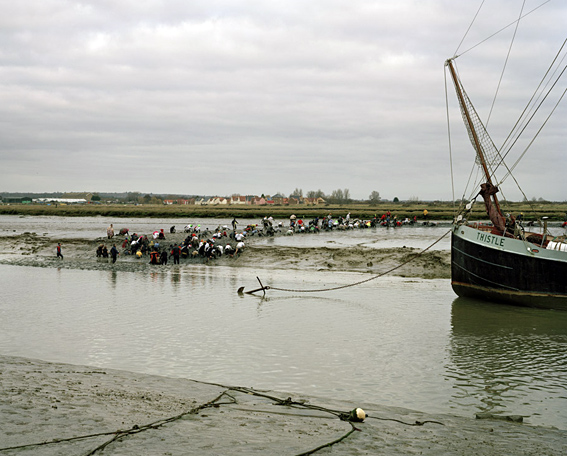THINK OF ENGLAND
October 15th, 2008 adminI’ve just come across this article by Blake Morrison on The Guardian website where he reflects on what our photographic heritage reveals about our changing national character

.
Think of England
Blake Morrison, May 19th 2007
“A photograph seeks to capture the present, but by its nature can only contain the past. However alive or ‘gritty’ or imbued with a sense of instantaneity, the photo can’t help but be nostalgic, since its subject (whether a face or a landscape) is frozen in the moment the shutter clicked – a remembrance of things past. When Philip Larkin, writing lines on his girlfriend’s photo album, said that photography is “as no art is, / Faithful and disappointing”, this was the paradox he tried to pin down – that on the one hand photos seem immediate and “empirically true”, but on the other they commemorate “just the past”:
Those flowers, that gate, 
These misty parks and motors, lacerate 
Simply by being over; you 
Contract my heart by looking out of date.
The Tate’s new exhibition of 150 years of photography in Britain is entitled How We Are. It’s a good and perfectly justifiable title, since the 500 images that are included, ranging from Julia Margaret Cameron and Lewis Carroll through Bill Brandt and Cecil Beaton to Chris Killip and Jane Bown, provide us with a composite portrait of ourselves as a nation. But the show is also the story of “how we were”, since even the most recent exhibits are a commemoration of lost time, and reveal not just what is constant in the British landscape and character, but how much is changing or has already changed. For the curators, Val Williams and Susan Bright, the defining characteristic of British photography is its obsession with the past, and the dominant images “taken in the frustrating place of the present, are infused, explicitly or implicitly, with a sense of melancholy”.
The convention is to think of photography as the most up-to-the-minute of art forms – not just because its practitioners are impelled (or commissioned) to record the latest fashion, the freshest innovation, the newest face on the block; but because (unlike novelists or film-makers) they lack the freedom to set their work in the past. But history no longer happens without a camera being present. And photographers have always been more preoccupied with history than their reputation would suggest. Among the earliest photos in the Tate show, from the 1860s, is one of Stonehenge taken by Colonel Sir Henry James: a moody tribute to ancestral pagan origins. And from the 1880s comes a shot of two women and a man frolicking in the hay in their Sunday best: a pastiche of bucolic bliss. Neither fulfils the expectation that most of us have about late 19th-century photography, in which industrial might or urban poverty dominates the picture: Brunel posing in top hat and cigar against a backdrop of massive iron chains; the waifs and urchins rescued by Thomas Barnardo, as photographed by Thomas Barnes. But as becomes clear from the Tate show, the Victorians were drawn to rural idylls and costume portraits – with photographers like Francis Bedford and Benjamin Brecknell Turner quick to supply their needs by producing images of reassuringly timeless landscapes.
For early exponents eager to establish photography as a respectable pursuit, the temptation was to imitate classical scenes and poses. It was as if the newness of photography could only pass muster if it succeeded in looking old, and the best way to do this was to aspire to the condition of painting. (The Tate show even includes a bizarre example, circa 1870, by Kate Gough, of the two media being mixed: on to the necks of three painted ducks swimming on a pond, three photographs of women’s heads have been superimposed.)
But honouring the past was more than a PR exercise on behalf of an upstart art form. Many photographers then and since have been motivated by the need to preserve something they believe or fear is disappearing. In the late 1960s, for example, the short-lived Tony Ray-Jones (1941-72) set out to record what he called the “daily anachronisms” of British life, such as beauty contests, carnivals, galas, dog shows and strongman contests. As the country became “more Americanised”, “reduced to an island or defrocked”, he wanted to pay tribute, as Orwell had before him, to the British (or, more specifically, English) people, with “their old-fashioned outlook, their graded snobberies, their mixture of bawdiness and hypocrisy, their extreme gentleness, their deeply moral attitude to life”. Forty years on, the national psyche seems to have changed (whatever happened to our gentleness and moral rectitude?) The territory Ray-Jones explored has since been reoccupied by others, including Martin Parr, whose photo of morris dancers performing outside a high-street McDonald’s commemorates the perilous survival of ancient British customs in the global marketplace.
There’s a similar spirit in the work of Homer Sykes, who in the 1970s compiled a set of photos of “traditional British customs”, morris dancing included, and published them in a book called Once a Year. It’s an extraordinary document, not least because most of these customs – though venerated over centuries and still carried out on particular days of the year – are so weird. Without Sykes, we might not know what’s involved in burning the clavie, wassailing the apple tree, dicing for maid’s money, dunting the freeholder, firing the fenny poppers or bottle kicking and hare pie scrambling – nor have heard of the haxey hood game, the wicken love feast, the Painswick clyping ceremony, the Hungerford hocktide or the Hinton punky night. It’s true that you can get by very well without knowing a thing about them and still feel British. But Sykes’s attention to the wackiness and paganism of these activities is not the usual pointless heritage industry fare. What interests him is the contemporaneity of the participants, the coexistence of ancient and modern.
Take his The Burry Man, for example, which celebrates a tradition still carried out annually in South Queensferry in the Firth of Forth: on the second Friday in August, in order to bring luck to the local herring industry by acting as a scapegoat, a man dresses up in a costume of freshly collected burrs and walks through the town, calling in at every pub to collect money and be given tots of whisky. What makes Sykes’s photo more than quaintly folkloric is the contrast between the eyeless, flower-festooned beastie, or “green man”, and his quotidian surroundings: the battered bar with Youngers beer mats; the sharp-faced helpers, in jackets and ties; the drab pub backdrop, with a dispensing machine. It’s the same with other images from this same series: we see ancient rituals being performed or observed by people in ribbed tank tops, thin floral dresses, miniskirts, flared trousers and Zapata moustaches. The effect is incongruous to the point of surrealism, yet it makes you see how rites that have seemingly outlived their usefulness can serve to bring a community together.
A distorted attachment to indigenous tradition can also drive communities apart, which is perhaps what led Sykes to embark on another project in the 1970s, when he took photographs of National Front members during their meetings. More dramatically, he was one of the photographers present when NF marchers clashed with anti-racist protesters in Lewisham in 1977, and the police used riot shields for the first time. As Sykes shows, an alertness to history can work in different ways.
Sykes comes from Vancouver. Ray-Jones, though born in Somerset, learned his art in the US. A striking aspect of the Tate show is how many iconic images of Britain and the British have been produced by outsiders: it’s as if we can’t see ourselves without their help. Among the artists featured are Otto Pfenninger, Bill Brandt and Albrecht Tübke (all German), Leonard Freed and Nancy Hellebrand (both from the US), Wolfgang Suschitzky (born in Vienna), Dorothy Bohm (Konigsberg), Horace Ove (Trinidad) and Vanley Burke (Jamaica). Others in the show – from Madam Yevonde in the 1930s (who grew up in Streatham but was educated in Belgium) to newcomers like Douglas Abuelo, Grace Lau and Penny Klepuszewska – have a perspective that helps them notice things which insiders might miss.
What they and the rest notice, invariably, is how eccentric the British are – or, rather, how much stranger and more interesting than we fancy ourselves to be. How fond of posing with exotic animals; how keen on dressing up and body painting; how obsessed with stardom (long before the age of celebrity); how drawn to clowns, mirrors, circuses, illusions, hats and masks; how shrill and gaudy in our choice of colours. There are more familiar images too, showing our attachment to gardens, villages and beaches. But, for the most part, this is the antithesis of the Picture Post view. The Britain that appears is dandier, showier, more European, more multi-ethnic. More arty, too: there’s a notable strain of surrealism, and in the context of the show even Wolfgang Suschitzky’s photograph of a bowler- hatted businessman outside Foyles in Charing Cross, circa 1936, begins to look like a meticulously orchestrated artwork rather than a piece of opportunistic social realism – the empty pavement, the lines and angles, the falling shadows are all beautifully arranged.
Though careful construction has always been part of the process, it also gives enemies the opportunity to shout “Cheat!” when they find that seemingly “true” photographs are works of artifice that have been set up. The Victorian Arthur J Munby insisted that the working women whose photos he assembled – pit girls, milkmaids, fisherwomen – wear suitably dirty working clothes. Walker Evans did much the same with his Alabama sharecroppers in the 1930s; Thomas Barnes found himself at the centre of a legal row over his “before” and “after” portraits of rescued waifs when the Rev George Reynolds objected, “He is not satisfied with taking them as they really are, but he tears their clothes, so as to make them worse.” There’s no denying Barnes had a propagandist purpose: to highlight poverty and class difference. But a sense of mission can sometimes help rather than hinder the making of art: without it, neither Barnes nor Evans would have created such powerful, aesthetically “pure” images. If we worry that their subjects were coerced and exploited, the Tate show reminds us that many people, not least the British, enjoy posing, crave the attention of the lens and are naturals at dolling themselves up.
Nowadays, people no longer need to go to studios for an image of themselves. The history of photography is, in part, the story of an art form becoming progressively more available to all – from daguerreotypes and the gelatin dry plate, through Leicas, 35mm film, Kodachrome and instamatics, to digital cameras, mobile phones and blogs. Though the Tate exhibition doesn’t go so far as to include phone camera images of 7/7, it does reflect the populism of the art – and its affinity with less privileged sections of society. A comparable show mounted 50 years ago would have offered a very different picture of the British, with greater emphasis on national pride, certitude and homogeneity. This one is postmodern, postcolonial and postmasculinist. Instead of generals and war heroes, we get Percy Hennell’s mutilated soldiers; instead of 1950s housewives in their kitchens, we get suffragettes (a radiant Christabel Pankhurst in 1912); instead of grouse-shooting toffs and flat-capped workers, we get Horace Ove’s Walking Proud, a photo of a black couple in 1971 – the woman tottering on platform heels, the man with his hands in his pockets, both of them wearing hats – the street clearing in their path, as if the world was all before them.
With only 500 images chosen from the millions available, and some wonderful photographers omitted, the Tate take on the British is necessarily partial and selective. But it does raise big questions about where our obsession with the past has brought us. How we are, on this evidence, is confused about who we are. But perhaps that’s not a bad place to be.”


